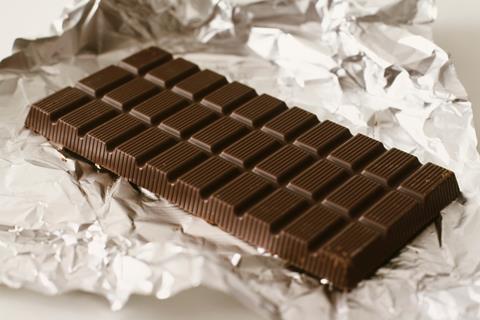
Chocolate has had a bitter pill to swallow. That pill is HFSS regulation, which has banned treats from prominent display areas in store. Combined with higher prices, that has resulted in a volume decline of 4% – higher than the 2.9% decrease we reported in 2022.
Only 11 of the 30 biggest brands have sold more chocolate, and all the major suppliers have been burned. Take Mondelez, owner of 10 of the top 30 brands. Together, their volumes are down 6%. Only Toblerone, Mini Eggs and Twirl are in volume growth.
Meanwhile, Mars Wrigley’s eight top 30 brands are down 2.5% in volume. And Nestlé’s five bestsellers – Milkybar, Kit Kat, Quality Street, Aero and Smarties – have suffered a combined volume loss of 11.4%.
Chocolate category volume losses and value gains
Despite this raft of volume losses, the category has grown 9.9% at a value level – thanks to a 14.5% rise in average price per kilo.
“Across chocolate confectionery segments, value growth has been driven by price increases, but corresponding volumes are declining,” confirms Karen Crawford, Lily O’Brien’s marketing director. “We can see consumers buying better but less frequently – purchasing chocolate as a ‘real treat’ with less spontaneity.”
That price sensitivity goes some way to explaining the difference between the winners and the losers in this table. “Many of the brands that saw the best performance increased price per volume in line or slightly behind the market rate,” says Lauren Hollis, senior analytics executive at NIQ.
“Meanwhile, the brands that have increased average prices faster than the market have seen sales decline.”
But that hasn’t been the only deciding factor. The October 2022 introduction of HFSS restrictions in larger stores has hit brands that are heavily reliant on sales of single bars, which were previously sold at till points. Wispa, Smarties and Mars have lost most in volume percentage terms. They’re down respectively 27%, 21.1% and 17.7%.
This was to be expected. NIQ data shared with The Grocer on the first anniversary of the rules revealed confectionery – including candy and chocolate – had suffered the greatest decline of any impulse category.
There’s a reason why chocolate has been hit even harder by HFSS rules than sugar confectionery. Chiefly, there is a lack of HFSS-compliant chocolate products on the market. Chocolate is mostly sugar and fat – Cadbury Dairy Milk, for example, is 56% sugar and 30% fat. Those proportions make reformulation problematic.
So, rather than take out ‘bad’ stuff, brands have tried putting in ‘good’ stuff. “We launched our first-ever non-HFSS treats this year,” says Mondelez trade comms manager Susan Nash. She’s referring to Cadbury Dairy Milk Fruitier & Nuttier bags of trail mix and snack bars, which were unveiled in February. Each 30g portion of the latter provides 11g sugar.
The four-strong range “features a delicious mix of raisins, sultanas, cranberries, roasted almonds and hazelnuts, all dusted with cocoa powder for that extra chocolatey Cadbury goodness”, Nash adds. “The products are lower in sugar and saturated fat, while being higher in fibre and protein, to give consumers a tasty choice for health-conscious snacking moments.”
Big chocolate brands navigate HFSS
Still, Fruitier & Nuttier hasn’t helped Dairy Milk avoid the greatest absolute volume loss of the year: 3.5 million kilos.
It’s similar news at Mars Wrigley. Despite HFSS-compliant Mars, Galaxy, Bounty and Snickers Triple Treat lines launching in 2022, these brands have struggled to nail growth.
Amid all this bad news, one bright spot remains in chocolate: gifting and seasonal lines. That’s exemplified by Mondelez brand Toblerone, which unveiled its premium Truffles in July. It’s up 23.7% in value on units up 18.4% – the sharpest volume rise of the year.
“It’s been an exceptional year for Toblerone due to brilliant marketing and innovation,” says Nash. She points to marketing support and limited-edition packaging coinciding with events such as Easter, Valentine’s Day, and Father’s Day.
“Seasons remain key to the brand’s success,” she adds. “Through challenging times, consumers often review discretionary spending. However, they are less likely to reduce their spending on confectionery gifting. We’re putting a strong focus behind eye-catching sharing and gifting formats.”
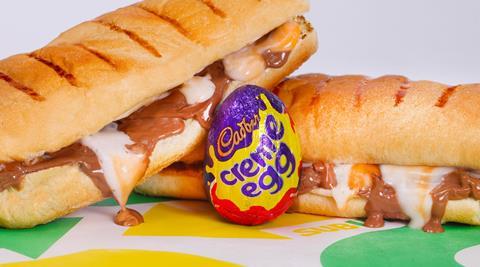
Cadbury conspired with Subway in the spring to produce a Cadbury Creme Egg sandwich. Promising “the ultimate savoury-sweet treat”, the six-inch sub was “golden toasted on the outside and deliciously gooey on the inside” and oozed “delicious, melted milk chocolate and soft fondant”. It was available free of charge for one day only – 7 April – from four Subway branches in London, Liverpool, Swansea and Glasgow.
Mondelez isn’t alone in its focus on gifting. Lindt & Sprüngli attributes the 14.6% value and 14.8% volume gains of its Lindt-branded products partly to increased demand for premium chocolate gifts, particularly at key seasonal occasions like Easter and Christmas.
A higher demand for gifts is a consequence of covid, suggests a spokeswoman. “An increased sense of connection and community followed lockdown, increasing the importance of gifting and celebrating – reflecting directly on gifting and sharing propositions,” she says.
Mars Wrigley is also cashing in on gifting and sharing. Celebrations, Maltesers and M&M’s have all bucked the general decline in chocolate volumes.
“We continue to see repeat and new shoppers purchase our range of blockbuster brands, from Celebrations to M&M’s, at key gifting occasions such as Christmas,” says comms manager Lauren George. “Innovation is at the heart of Mars Wrigley’s portfolio, and Celebrations comes into its own at Christmas.”
Top-selling in chocolate gifting
To seize the opportunity in 2023, the supplier has rolled out festive NPD such as Maltesers Assorted Truffles and the Tesco-exclusive Maltesers Mint Truffles.
Many other brands are touting seasonal specials ahead of Christmas, in a bid to end a challenging year on a more positive note.
Lily O’Brien’s, for instance, has launched a Christmas Desserts Collection. “With new limited-edition flavours and designed as a larger 24-piece format, it’s a perfectly placed ‘trade up’ box for the season,” explains Crawford.
“Gifting products are always more resilient than self-treating chocolate and seem to be weathering the cost of living crisis much better. Generally, when the consumer purse is squeezed, they tend to prioritise gifting loved ones over treating themselves,” she adds.
That’s no doubt one reason why Mars shelled out £534m in November for Hotel Chocolat. Because if high-end gifting remains the bright spot of the category, the brand is certainly in the right place.
Top Launch 2023
Toblerone Truffles | Mondelez
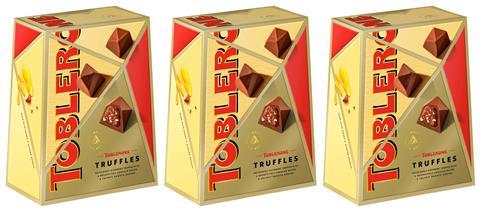
Triangular treat Toblerone took on a new shape in July. It rolled out these individually wrapped diamond-shaped chocolate truffles with a “velvety centre” and tiny pieces of crunchy honey & almond nougat. But that’s not the only reason why Truffles (rsp: £6.09/180g) is our chocolate launch of the year. The innovation is a savvy response to the ongoing changes in how Brits consume chocolate. Single bars and on-the-go bags are out; premium gifts are in. So Truffles is bang on trend.







![Beans Face Off_RGB[18]](https://dmrqkbkq8el9i.cloudfront.net/Pictures/100x67/9/5/1/311951_beansfaceoff_rgb18_56926_crop.jpg)















































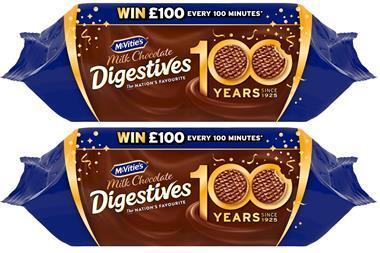
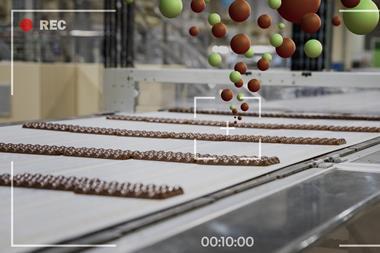

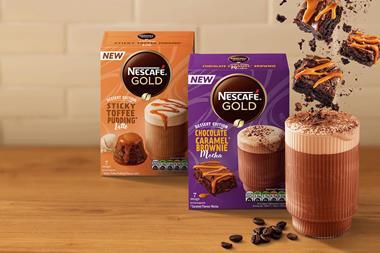

























No comments yet